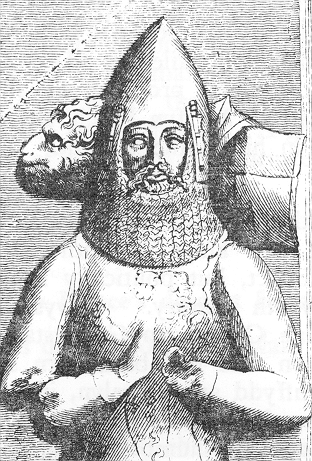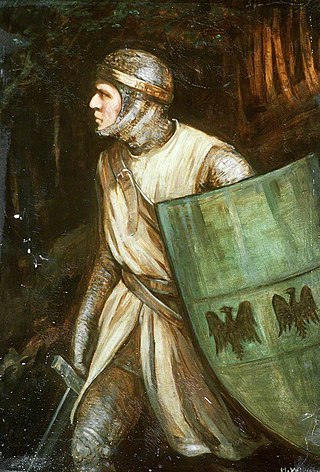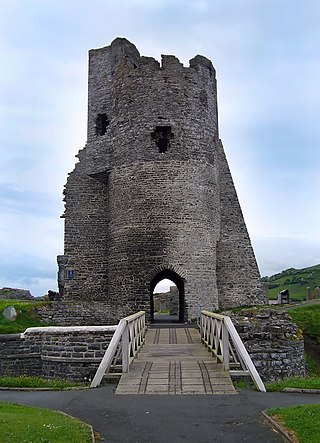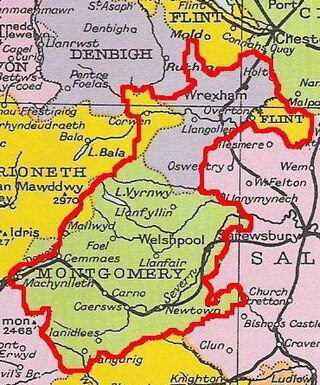Related Research Articles

Rhys ap Gruffydd or ap Gruffudd was the ruler of the kingdom of Deheubarth in south Wales from 1155 to 1197. Today, he is commonly known as The Lord Rhys, in Welsh Yr Arglwydd Rhys, although this title may have not been used in his lifetime. He usually used the title "Proprietary Prince of Deheubarth" or "Prince of South Wales", but two documents have been discovered in which he uses the title "Prince of Wales" or "Prince of the Welsh". Rhys was one of the most successful and powerful Welsh princes, and, after the death of Owain Gwynedd of Gwynedd in 1170, the dominant power in Wales.

Owain ap Gruffudd was King of Gwynedd, North Wales, from 1137 until his death in 1170, succeeding his father Gruffudd ap Cynan. He was called Owain the Great and the first to be styled "Prince of Wales" and the "Prince of the Welsh". He is considered to be the most successful of all the North Welsh princes prior to his grandson, Llywelyn ab Iorwerth. He became known as Owain Gwynedd to distinguish him from the contemporary king of Powys Wenwynwyn, Owain ap Gruffydd ap Maredudd, who became known as Owain Cyfeiliog.

Gruffydd ap Llywelyn was King of Gwynedd and Powys from 1039 and, after asserting his control over the entire country, claimed the title King of Wales from 1055 until his death in 1063. He was the son of Llywelyn ap Seisyll king of Gwynedd and Angharad daughter of Maredudd ab Owain, king of Deheubarth, and the great-great-grandson of Hywel Dda. Gruffydd was the first and only Welsh king to unite all of Wales albeit for a brief period. After his death, Wales was again divided into separate kingdoms.

Gruffudd ap Cynan was King of Gwynedd from 1081 until his death in 1137. In the course of a long and eventful life, he became a key figure in Welsh resistance to Norman rule.

Deheubarth was a regional name for the realms of south Wales, particularly as opposed to Gwynedd. It is now used as a shorthand for the various realms united under the House of Dinefwr, but that Deheubarth itself was not considered a proper kingdom on the model of Gwynedd, Powys, or Dyfed is shown by its rendering in Latin as dextralis pars or as Britonnes dexterales and not as a named land. In the oldest British writers, Deheubarth was used for all of modern Wales to distinguish it from Hen Ogledd, the northern lands whence Cunedda originated.

The Kingdom of Gwynedd was a Welsh kingdom and a Roman Empire successor state that emerged in sub-Roman Britain in the 5th century during the Anglo-Saxon settlement of Britain.

Aberystwyth Castle is a Grade I listed Edwardian fortress located in Aberystwyth, Ceredigion, Mid Wales. It was built in response to the First Welsh War in the late 13th century, replacing an earlier fortress located a mile to the south. During a national uprising by Owain Glyndŵr, the Welsh captured the castle in 1404, but it was recaptured by the English four years later. From 1637 it housed a Royal mint of Charles I, which minted coins from locally mined silver. The castle was slighted by Oliver Cromwell in 1649.
Gruffydd ap Rhys was Prince of Deheubarth, in Wales. His sister was the Princess Nest ferch Rhys. He was the father of Rhys ap Gruffydd, known as 'The Lord Rhys', who was one of the most successful rulers of Deheubarth during this period.
Maelgwn ap Rhys was prince of part of the kingdom of Deheubarth in south west Wales.
Gwenllian ferch Gruffydd was a 12th century Welsh rebel and Princess consort of Deheubarth. The daughter of Prince of Gwynedd Gruffudd ap Cynan and member of the House of Aberffraw, she married Gruffydd ap Rhys, the Prince of Deheubarth, and would lead a "patriotic revolt" with him during the Great Revolt of 1136 until her death at the battle at Kidwelly Castle.
Hywel ab Owain Gwynedd, king of Gwynedd in 1170, was a Welsh poet and military leader. Hywel was the son of Owain Gwynedd, king of Gwynedd and an Irishwoman named Pyfog. In recognition of this, he was also known as Hywel ap Gwyddeles. Hywel is also known as the Poet Prince for his bardic skills.

Madog ap Maredudd was the last prince of the entire Kingdom of Powys, Wales. He held for a time, the FitzAlan Lordship of Oswestry, family of the Earls of Arundel, of Arundel Castle. His daughter married Lord Rhys, prince of Wales.
Anarawd ap Gruffydd was a Prince of Deheubarth in Southwest Wales.
Cadwaladr ap Gruffydd was the third son of Gruffudd ap Cynan, King of Gwynedd, and brother of Owain Gwynedd.

Gruffydd Maelor II was a Prince of Powys Fadog. He reigned for thirty-three years and married into the House of Stanley. Following the Anglo-Welsh Treaty of Montgomery, he submitted to Llywelyn ap Gruffudd, Prince of Wales.
This article is about the particular significance of the century 1101–1200 to Wales and its people.

The history of Gwynedd in the High Middle Ages is a period in the History of Wales spanning the 11th through the 13th centuries. Gwynedd, located in the north of Wales, eventually became the most dominant of Welsh polities during this period. Contact with continental courts allowed for Gwynedd to transition from a petty kingdom into an increasingly sophisticated principality of seasoned courtiers capable of high level deplomacy and representation; not only with the Angevine kings, but also the king of France and the Papal See. Distinctive achievements in Gwynedd include further development of Medieval Welsh literature, particularly poets known as the Beirdd y Tywysogion associated with the court of Gwynedd; the reformation of bardic schools; and the continued development of Cyfraith Hywel. All three of these further contributed to the development of a Welsh national identity in the face of Anglo-Norman encroachment of Wales.

The House of Aberffraw was a medieval royal court based in the village it was named after, Aberffraw, Anglesey within the borders of the then Kingdom of Gwynedd. The dynasty was founded in the 9th century by a King in Wales whose descendants founded the Welsh Royal Houses. The other medieval Welsh dynasties were the Royal Houses of Dinefwr, Mathrafal.
References
- ↑ The Acts of Welsh Rulers: 1120-1283. University of Wales Press. 1 October 2010. p. 23. ISBN 978-0-7083-2387-8.